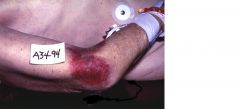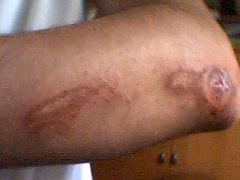![]()
![]()
![]()
Use LEFT and RIGHT arrow keys to navigate between flashcards;
Use UP and DOWN arrow keys to flip the card;
H to show hint;
A reads text to speech;
29 Cards in this Set
- Front
- Back
|
Degree of tissue damage due to blunt force trauma is determined by these 3 things
|
1. rate of transfer of force
2. surface area where force is applied 3. area of body injured |
|
|
Contusion (bruise)
|

mechanical injury that produces focal hemorrhage
|
|
|
Pooled blood within tissue
|
hematoma
|
|
|
In a contusion, macrophages change hemoglobin into ________ (blue --> yellow--> green)
|
bilirubin
|
|
|
Abrasion
|

frictional force to epidermis or scraping of the epidermis causes hemorrhage in exposed dermal vessels
|
|
|
Abrasion over large area = ?
|
Brush Burn
|
|
|
disruption of skin and underlying soft tissues or internal organs due to external force
|
Laceration
|
|
|
In a _______ injury, intact bridging blood vessels, nerves, and connective tissue remain intact
|
laceration
|
|
|
Wound produced by a sharpened weapon
|
Incised Wound
|
|
|
Surface > Depth
|
Incised wound
|
|
|
Depth > Surface
|
Stab wound
|
|
|
Example of a 1st degree burn
|
sunburn
|
|
|
Explain 2nd degree burn
|
"Partial-Thickness" dermal epithelial structures are spared. Blistering and destruction of the epidermis and slight damage to underlying dermis
|
|
|
Explain 3rd degree burns
|

"Full-thickness" Dermal epithelial structures are entirely destroyed.
Skin Graft is required |
|
|
___% full-thickness body surface burns are potentially fatal
|
40%
|
|
|
#1 cause of death due to thermal burns
|
Infection, usually P. aeruginosa
|
|
|
4 Complications of Thermal Burns
|
1. Adult respiratory distress syndrome from inhalation of smoke or hot gases
2. Fluid loss 3. Infection 4. Contractures |
|
|
Electrical Energy is converted to _______
|
heat
|
|
|
Electrical energy applied to skin causes __1__. It is a __2__ burn with __3__ margins. It disrupts the __4__ system. High voltage may cause __5__. Lightning produces a __6__ pattern.
|

1. cutaneous burn
2. punched-out 3. blackened 4. cardiac 5. charring 6. fern-like |
|
|
__1__ current is more dangerous than __2__ current
|
1. alternating
2. direct |
|
|
Alternating current produces __1__.
Direct current produces a __2__. |
1. tetanic contractions
2. single shock |
|
|
The size of pure lead balls that weigh one pound
|
Gauge
|
|
|
The entrance wound is usually __1__ and __2__ than the exit wound
|
1. smaller
2. rounder |
|
|
Exit wounds are usually __1__ and have a __2__ shape
|
1. larger
2. stellate |
|
|
Ring of dirt on the clothing
|
Bullet wipe
|
|
|
Entrance wounds have a round perforation on the skin with a ________
|
abrasion collar
|
|
|
Stellate-shaped containing powder and soot
|
Contact wound
|
|
|
Long range wounds cause no _______ and have no ______
|
powder tattooing (stippling)
Abrasion collar |
|
|
Bullets that tend to always fragment
|
Rifle
|

